After a strong end to the previous campaign which saw Arsenal lift the FA Cup – their first major trophy since 2017 – a lot was expected of the Gunners. Mikel Arteta was hailed as the man who would guide them in the post-Wenger rebuild, and so far, he is doing a stellar job. Some smart summer signings have seen the Londoners’ performances improve, and even though these are early days, the signs look promising for them.
When Arteta joined midway through the previous campaign, he deployed a 4-2-3-1 most of the time. Some have suggested that the switch to a 3-4-3 this season is only temporary and enforced due to injuries, but that probably is not the case. Most of these absentees are the centre-backs, so it makes no sense to add an extra man in the back-line to cope with injuries. Therefore, it is most likely that Arteta and his coaching staff have been working on these tactics through the pre-season, and this is probably the way Arsenal will line up going forward, so it is worth an analysis.
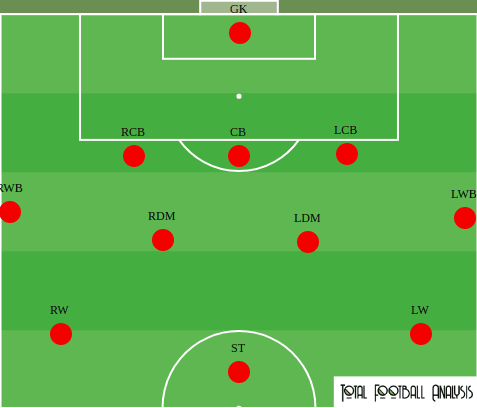
On paper, this looks like a simple 3-4-3 that many other sides have deployed, but in practice, it is very different from those shapes. Here, we will take a look at the system that Mikel Arteta has employed at Arsenal in the 2020/21 campaign so far in a tactical analysis.
Defensive shape against stronger opposition
Last season, Arsenal conceded 48 goals in the Premier League – the eighth-best defensive record in the division. It was clear to Arteta that he would need to improve that record to take the Gunners further up the table. Summer signing Gabriel and returning loanee William Saliba have added depth to the centre-back role, and perhaps that is what has enabled the Gunners to switch to a formation with three central defenders.
The pros of the new formation include better defensive stability against top opposition. Three centre-backs and two wing-backs can cope against sustained pressure in a much better manner, as was evident in Arsenal’s Community Shield clash against Liverpool.
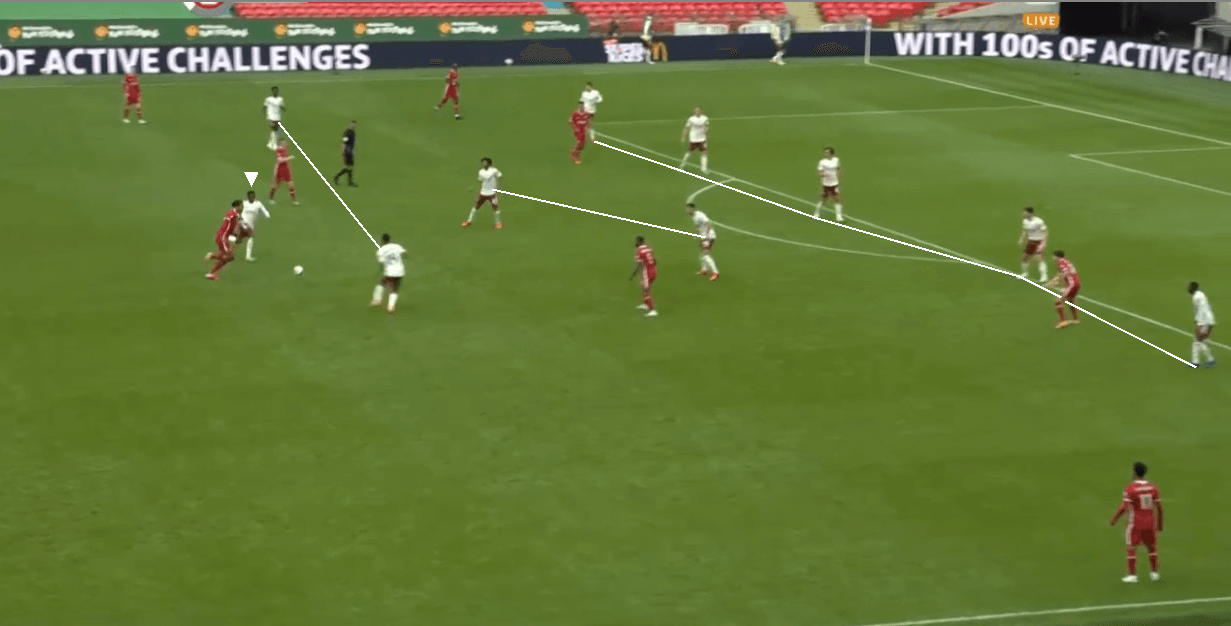
After scoring early on in that match, Arsenal were looking to sit back and absorb the pressure that Liverpool were mounting for an equaliser. They did so by switching to some sort of a 5-2-2-1, as is evident here.
Clearly, Arsenal have dropped deep into their own half and are inviting Liverpool to come forward. The key is that they are maintaining a solid defensive shape with an almost-flat back-five, two holding midfielders, two wingers who are operating in a much-narrower role and a sole striker.
Another advantage of this defensive shape is the flexibility it gives to the wingers. They can stay narrow and hold formation, push forward to press and create a 5-2-3, drop in the midfield line to provide support on the wings and make a 5-4-1 or move in different directions to form a 5-3-2.
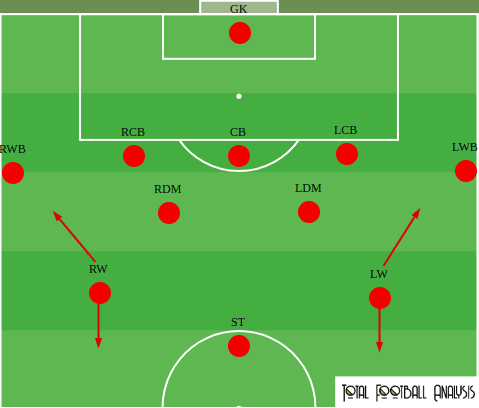
The fact that Arsenal were able to contain Liverpool in the Community Shield and allow only two shots on target is testament to the success of the new defensive shape, and the Gunners will hope that they can keep defending as they have been doing.
Pressing
Against less aggressive opposition, Arsenal have not shied away from pressing high up the pitch. The main objective of their pressing was not to win the ball in the offensive third, but rather to force the opponents to go long and clear the ball so that they could reset and build from the back.
To achieve that, they keep a -1 in the pressing phase; there is one less Arsenal player pressing the ball than the number of opposition players around it. They use the extra man in midfield to win the second ball after the opponents are forced to clear, and this also provides a screen in front of the defence in case the opponents manage to break the press.
This style of pressing was evident in Arsenal’s Premier League opener against Fulham.
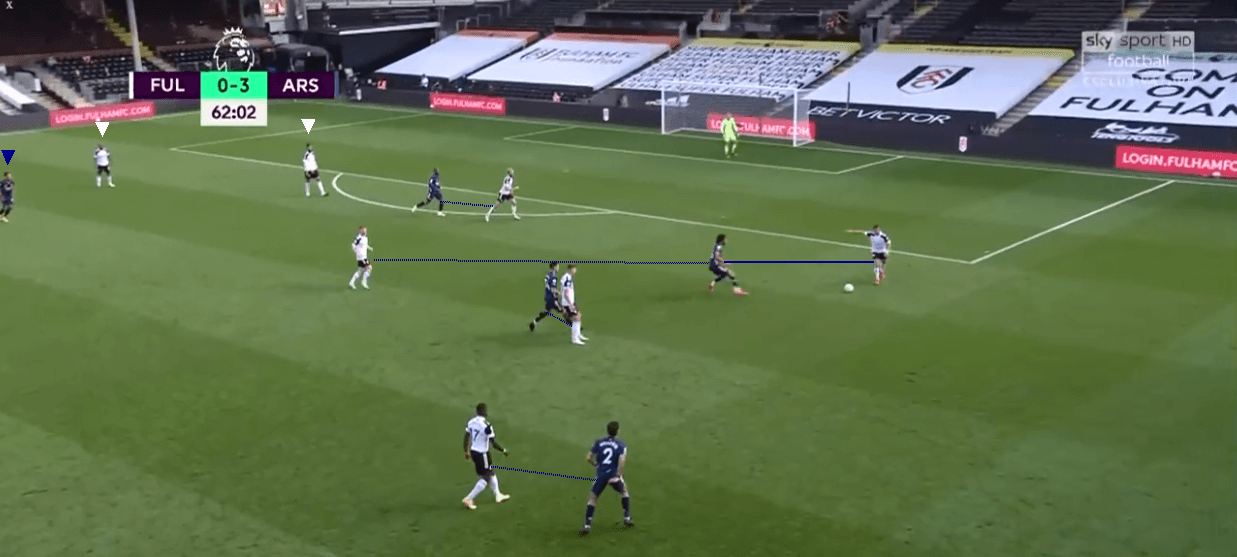
Depending on which side of the pitch the ball is on, one of the two midfielders pushes forward to join the striker. In this case, the ball is on the right, so the right midfielder Mohamed Elneny moves ahead. Notice how he isn’t exactly all over the man in possession and is also focusing on keeping one player in his cover-shadow. Elsewhere, Granit Xhaka is staying tight to a midfielder, Héctor Bellerín is close to the winger and Alexandre Lacazette is staying tight to a centre-back. Fulham’s numerical advantage is on the far side where Pierre-Emerick Aubameyang is around two defenders, but they can’t access that and are forced to punt the ball up the pitch.
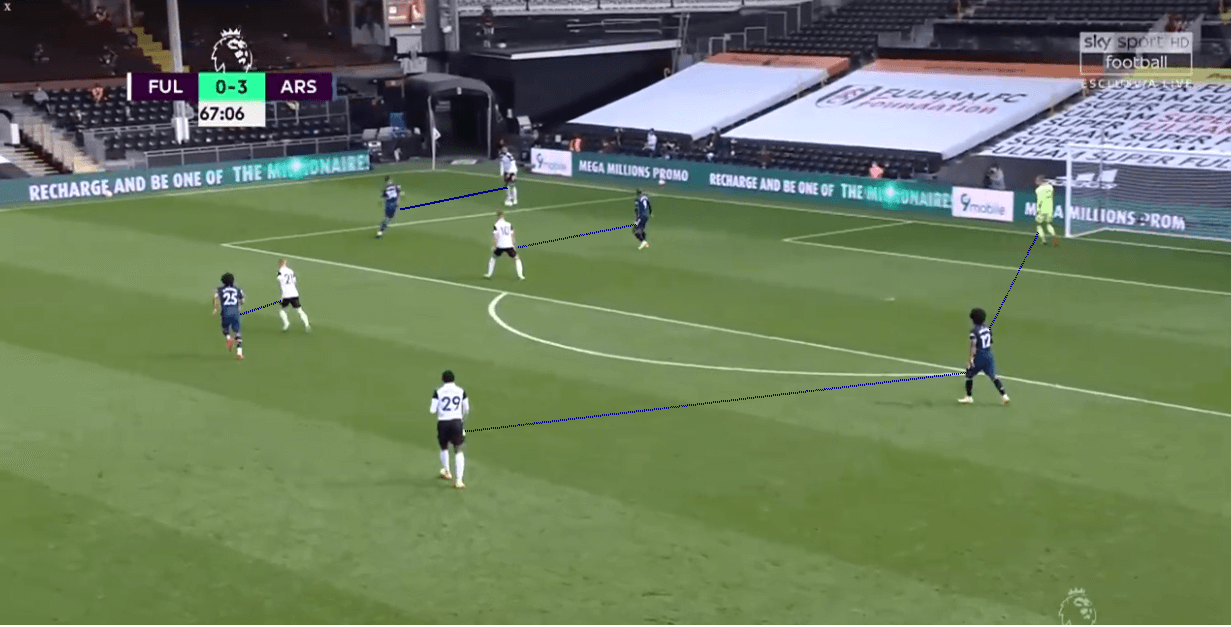
In this case, the ball is on the left-hand side, so Granit Xhaka has pushed ahead to press. Around him, Lacazette is keeping a centre-back occupied, Elneny is tight to a midfielder and Willian has positioned himself perfectly to intercept an aerial ball played to the midfielder with 29 on the back of his shirt, while also being close enough to the keeper to press him in case the ball goes to him.
This style of pressing helps Arsenal to recover possession quickly but in their own half, so they can regroup and build from the back once again. One reason for the emphasis on recycling possession with their defensive players is that the Gunners completely change their formation when they have the ball.
Changes in shape with possession
After recovering possession, Arsenal quickly switch from a setup with three centre-backs to a back-four. Their new formation can be described as something between a 4-3-3 and a 4-2-4; a 4-2-1-3 with the ‘1’ operating on the left and not centrally.
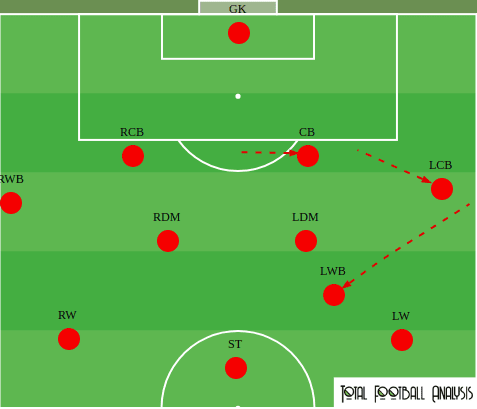
The switches are as follows: the left centre-back drifts wide to move into the area of a left-back with the man in the middle of the back-three taking his place at the heart of defence. The left wing-back pushes beyond the midfield line and almost joins the frontmen, while the right wing-back doesn’t go that far forward. The rest of the players stay put.
This was first seen in the Community Shield against Liverpool.
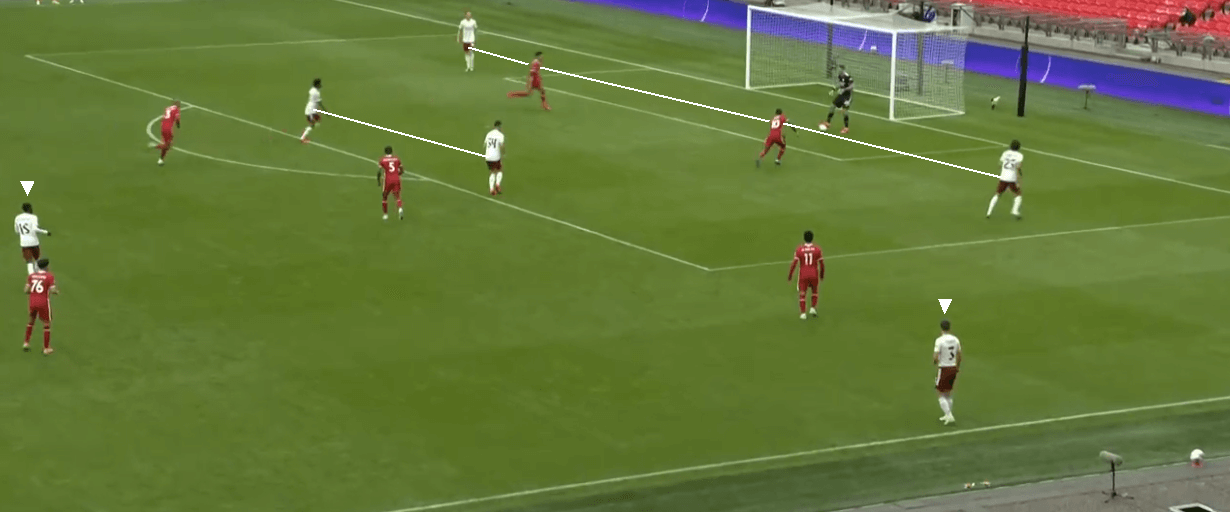
All of the changes can be seen in this frame, as Kieran Tierney, the left centre-back has moved to left-back with David Luiz taking his place. Rob Holding is the other centre-back. Further ahead, you can see how Ainsley Maitland-Niles, the left wing-back has gone far beyond the two midfielders and is positioned slightly closer to the left.
Arsenal did all of this to facilitate passing their way out from the back – something that Mikel Arteta has clearly put a lot of emphasis on.
Emphasis on playing out from the back
Arsenal have almost never gone long from goal-kicks and rarely clear the ball when they win it back in their defensive third. This is because they like to be slow and patient in their build-up play rather than directly threatening the opposition.
Against less aggressive opposition, this is easy because there is little pressure on the ball, but the difficult bit comes when they reach the attacking third, where they face a resolute defence. Against opponents that like to press very high up the pitch, however, it’s quite different. Playing out from the back becomes a high-risk-high-reward manoeuvre, as losing the ball in such a position would almost certainly lead to a goal conceded, but breaking the press would leave their attacking players one-on-one with the opposing defenders and create good goal-scoring opportunities.
That was exactly the case in the Community Shield against Liverpool.
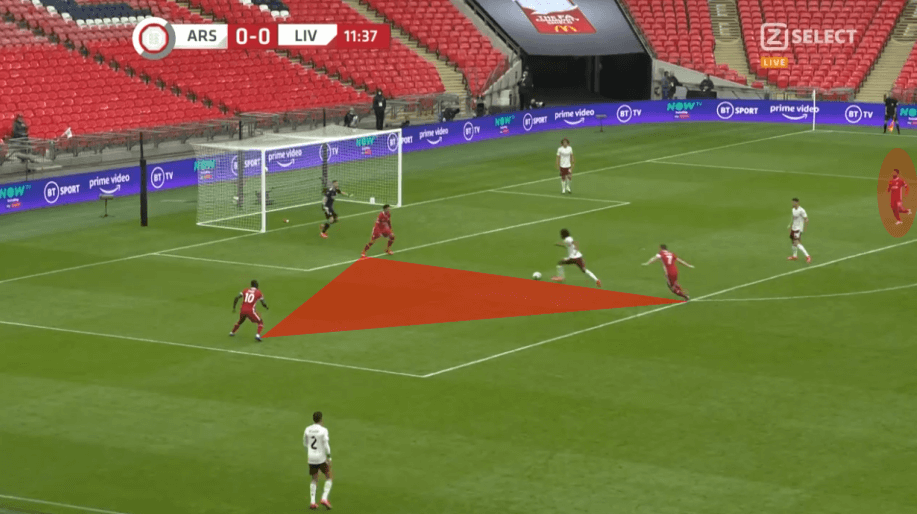
In this position, Liverpool have more outfield players in Arsenal’s box (4) than the Gunners do (3). While this places the Reds in a great situation to capitalise if they manage to nick the ball, it also leaves fewer men to defend if Arsenal manage to break the press.
Only three passes later, this was the position that Arsenal found themselves in.
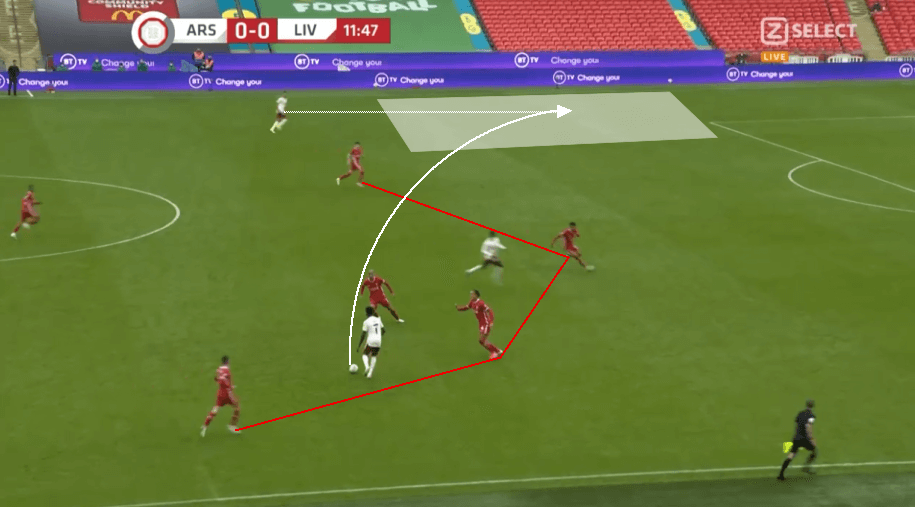
Liverpool’s back-four is terribly stretched, and there is an acre of space for Pierre-Emerick Aubameyang on the far-side. All Bukayo Saka has to do is find him with an aerial ball, and then the Arsenal captain is left face-to-face with a defender. On this occasion, Aubameyang managed to get a shot away from the edge of the box, and that is how Arsenal scored in the Community Shield.
Arsenal also looked to draw their opponents in, before moving forward in way of attack, which they did thanks to their patient build-up play.
Patient build-up
Along with the emphasis on building from the back, Mikel Arteta wants his men to be patient and wait for the correct moment before playing an advanced pass. They bide their time to draw in the opponents and stretch their lines, before quickly exploiting this with some quick passing.
This was evident before the Gunners’ second goal in their 0-2 EFL Cup victory over Leicester City.
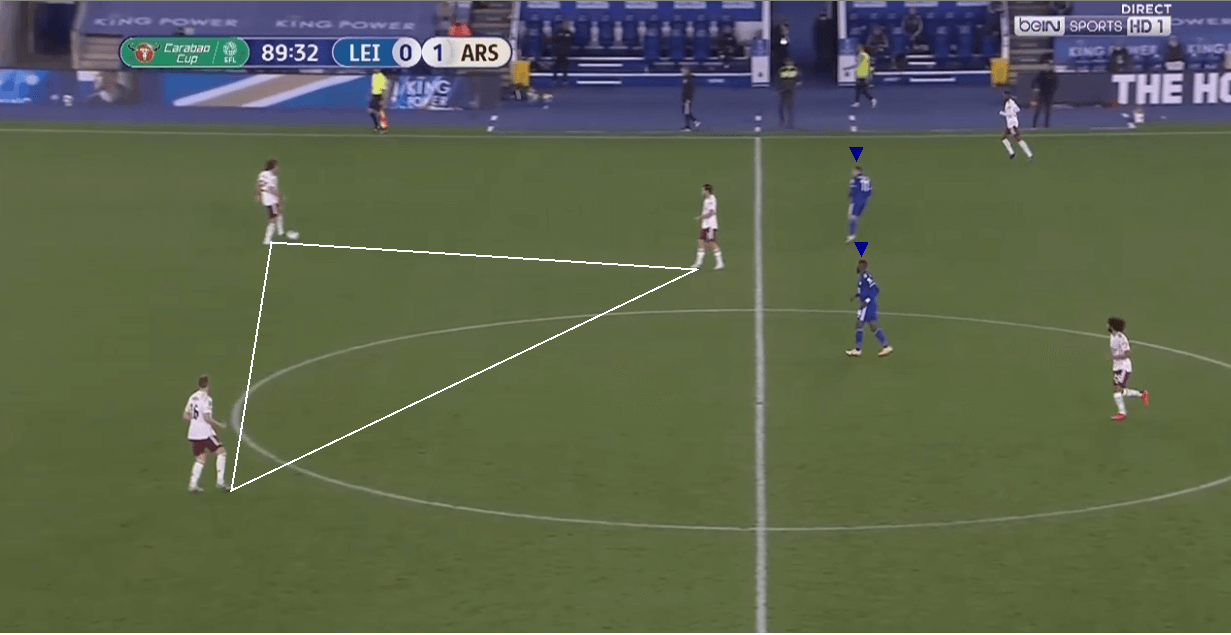
Here, Arsenal are recycling possession with their centre-backs inside their own half. Dani Ceballos has dropped deep from midfield to create a triangle and be an added passing option. Only two Leicester players are around the halfway line, so Arsenal are trying to draw the rest of the Foxes’ attackers and midfielders further away from their goal. They did so by passing the ball around between David Luiz, Rob Holding and Ceballos.
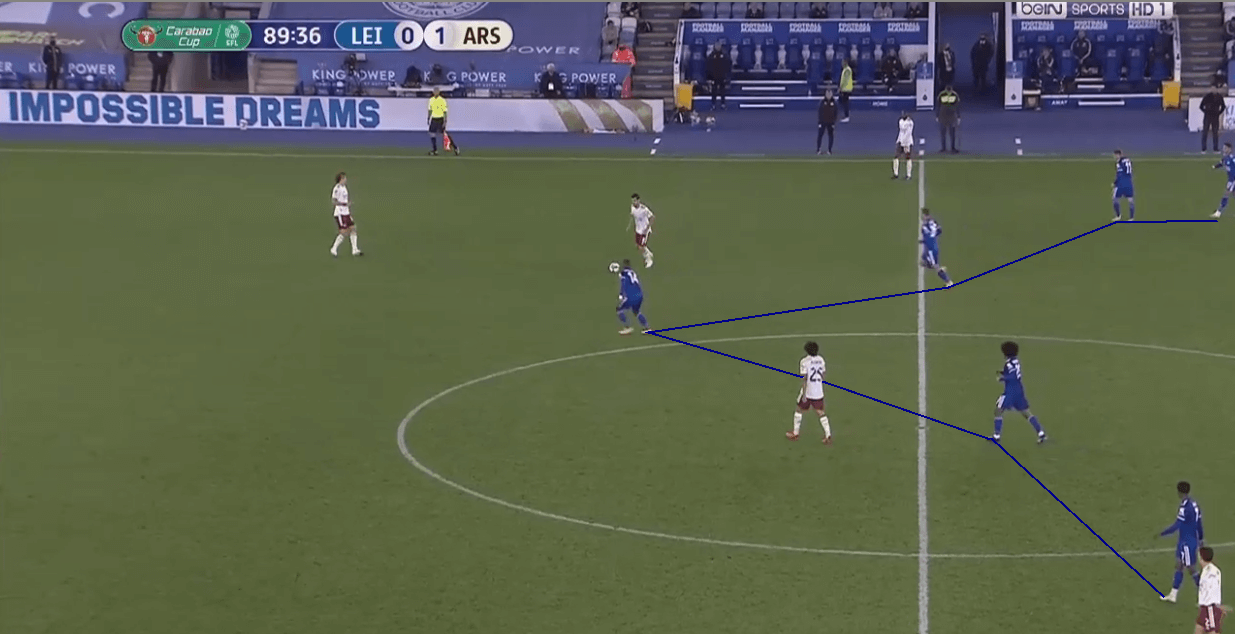
Quickly, six Leicester players appear over 40 yards away from their goal. When the time is right, Arsenal quickly up the tempo and move forward with a progressive pass over the top of the midfield.
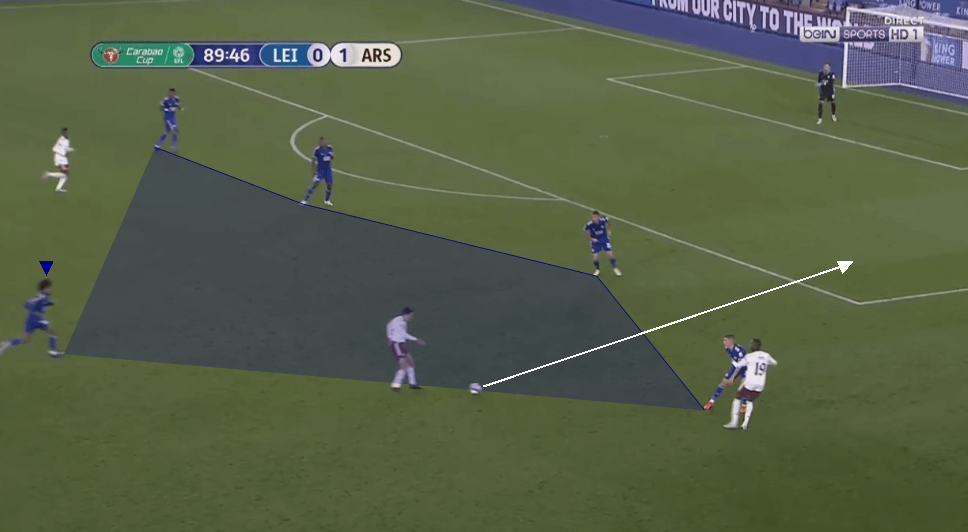
Nicolas Pépé receives it, and he brings it down for substitute Héctor Bellerín. Hamza Choudhury is the only Leicester midfielder in frame, and there is a massive pocket of space between him and the back-four. Bellerín looks to exploit a gap in the defence with his fresh legs and a quick turn of speed.
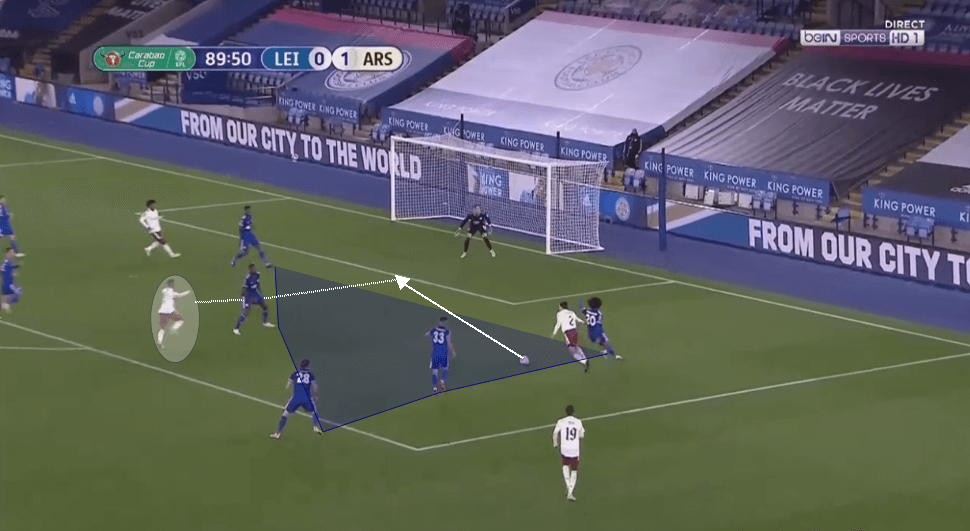
When he gets inside the box, you can see that the Leicester defence is in an absolutely terrible state. Nobody is close enough to the six-yard box, so Bellerín decides to play it into the path of Eddie Nketiah’s run. In this manner, Arsenal carved their opponents’ defence open simply yet effectively.
While Arsenal can draw high-pressing opposition like Liverpool or sides chasing a goal like Leicester in with such a slow build-up, this tactic doesn’t work against defensive sides. In those cases, the extra man in attack makes the difference.
Extra man in attack
Pushing the left wing-back so far forward was nothing short of a masterstroke on Mikel Arteta’s part because it confuses the opposing defence and pulls it around in all sorts of directions. This, in turn, helps the Arsenal forwards in finding pockets of space in the danger area.
The extra attacker worked an absolute treat against West Ham in the Premier League, as we will see below.
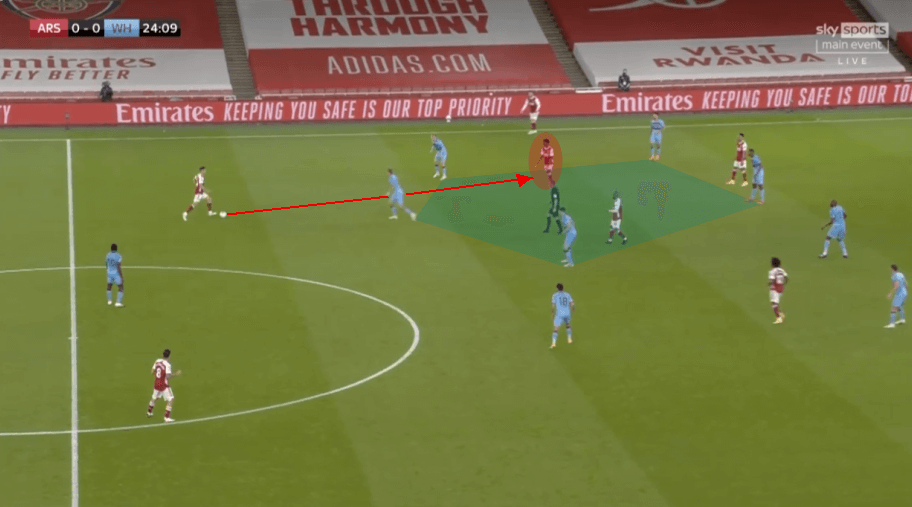
In this match, Bukayo Saka was the left wing-back, so he was the one who was tasked with getting forward and unlocking West Ham’s defence. In the buildup to the opener, he did just that by slotting into a sweet pocket of space between the opponent’s midfield and defence.
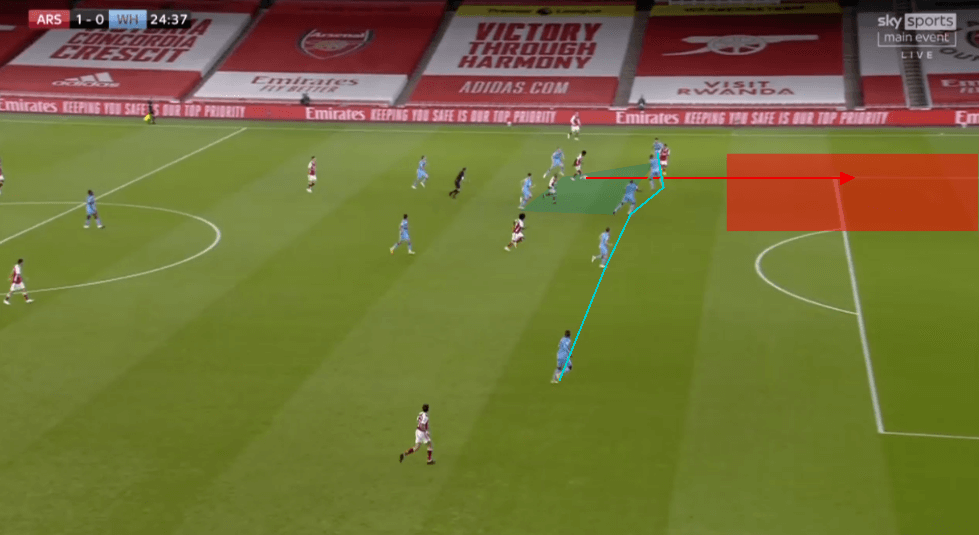
The teenager then had time to turn and slip a pass to Pierre-Emerick Aubameyang, who could run in behind the defence. The Gabonese international then got the assist, but it was Saka who created the goal with his smart positioning.
In fact, the left wing-back is essentially allowed to roam freely as long as he is close enough to the left wing. This was evident as Saka also got the pre-assist for the winner in the same match.
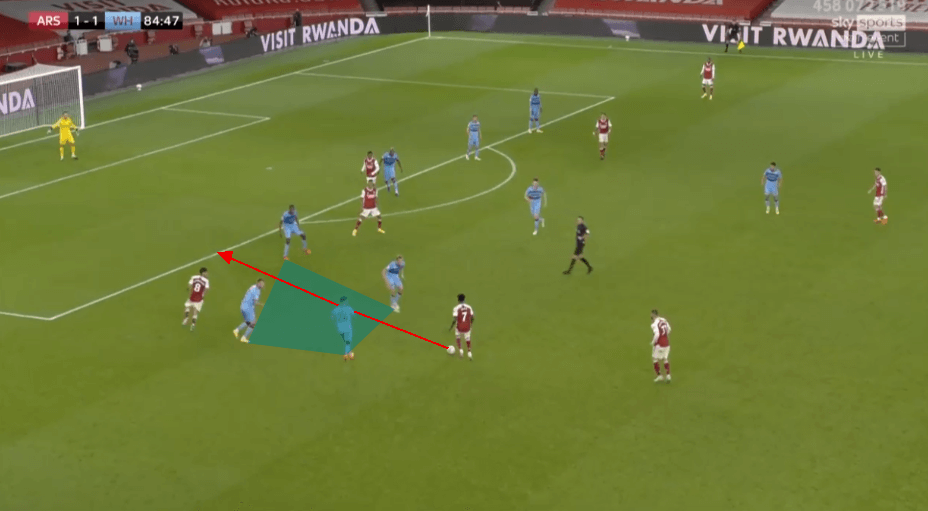
As Arsenal were pushing late on, Dani Ceballos did well to quietly sneak around the West Ham midfielders and right wing-back. So, when Saka got on the ball, he was able to drift inside, and when the angle opened, he slipped the perfect through ball for Ceballos who found himself in a brilliant position to square it for the striker. Yet again, the goal was created because of how Saka positioned himself and worked the perfect angle for a through pass.
Recently, Arteta has experimented with some changes on the right flank too.
Pseudo-right-back
In Arsenal’s match against Sheffield United, an interesting pattern was visible on the right flank. Héctor Bellerín, the right-wing-back, was asked to push even further forward than usual, while Mohamed Elneny, the right-sided midfielder stayed back in attack and moved to the right, covering the space left open by Bellerín.
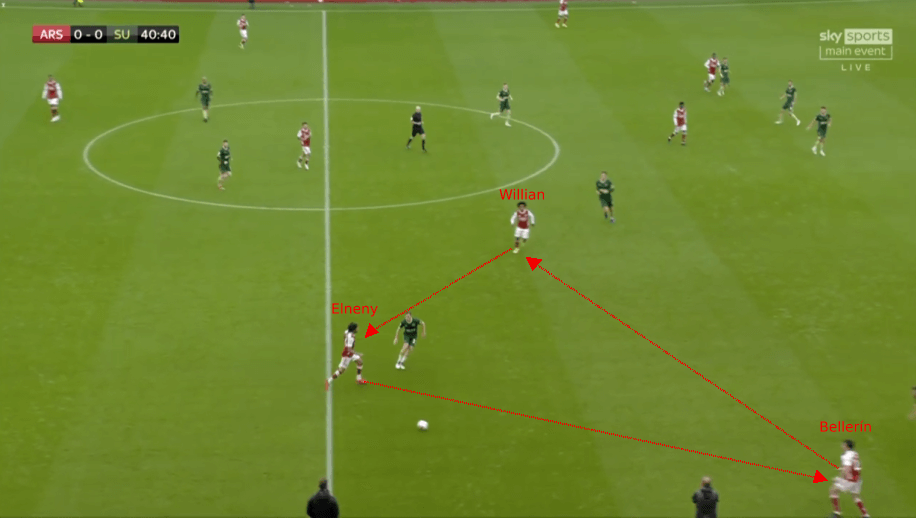
In a way, this was a three-way swap. Willian, the right-winger is involved as well as he moves into a central position where you would expect to see a midfielder. Bellerín occupies an attacking role on the right flank, while Elneny is behind him.
Additionally, this meant that Elneny could make late runs forward and serve as a third man on the right flank in attack. This was exactly what eventually helped Arsenal break Sheffield United down and open the scoring.
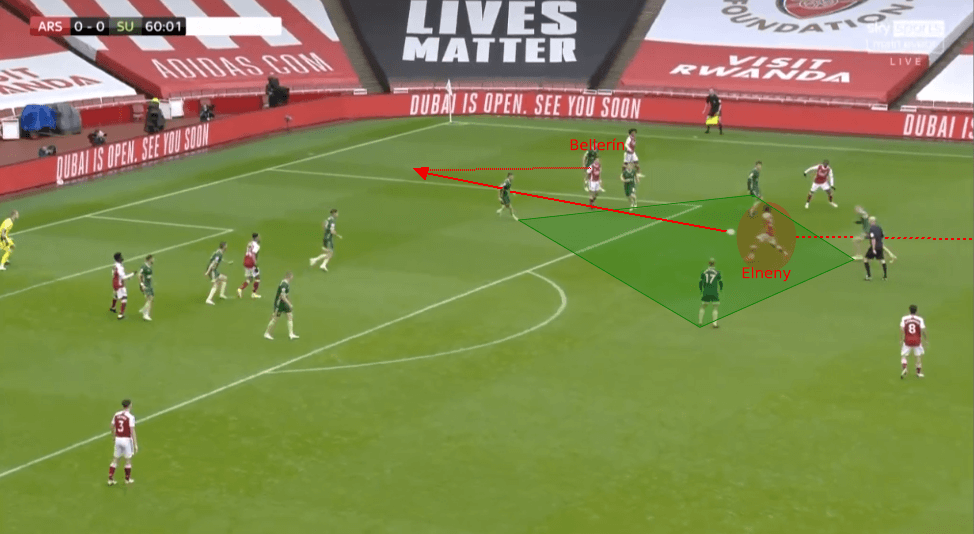
Here, Mohamed Elneny has made a late run from deep to arrive into a nice pocket of space between Sheffield’s lines. Because of Bellerín’s forward position, Elneny is able to slip the wing-back in behind with a first-touch pass. The Spaniard then clipped in a delicious cross to the back post from the byline, which was headed home to give Arsenal the lead.
Those were quite a few strengths of Mikel Arteta’s system at Arsenal, but now, let’s take a look at it’s biggest weakness.
Weakness against counterattacks
Basic tactical knowledge will tell you that one of the major weaknesses of a back-three is on the wings because if the opposing wingers are able to get in behind the wing-backs, they can be a major threat. In Arsenal’s case, this is magnified, particularly on the left flank as the left wing-back pushes far forward. When the opponent turns the ball over and breaks quickly, the left wing-back will never be able to get back in time, and the defence will have a gaping hole on that side.
West Ham made the most of this issue when they scored against Arsenal in the Premier League.
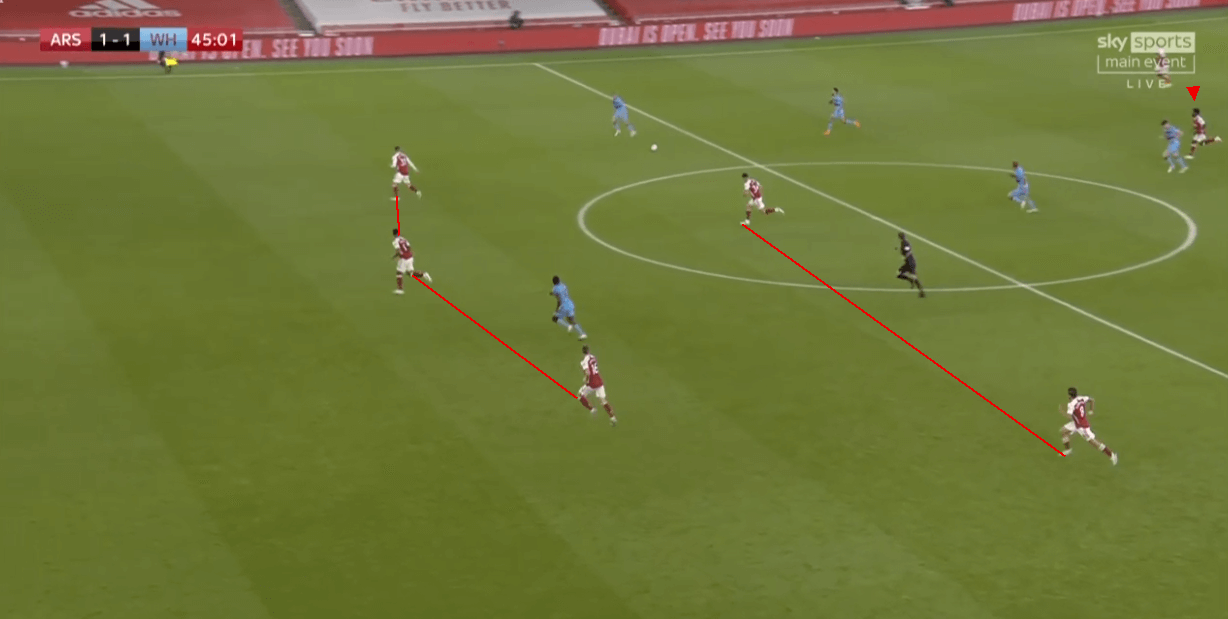
In this instance, Saka is on the far-right of the frame, and has five West Ham players between him and his centre-backs. In fact, Arsenal are effectively defending this counterattack with just a back-three and two midfielders, as even the right wing-back is out of the frame.
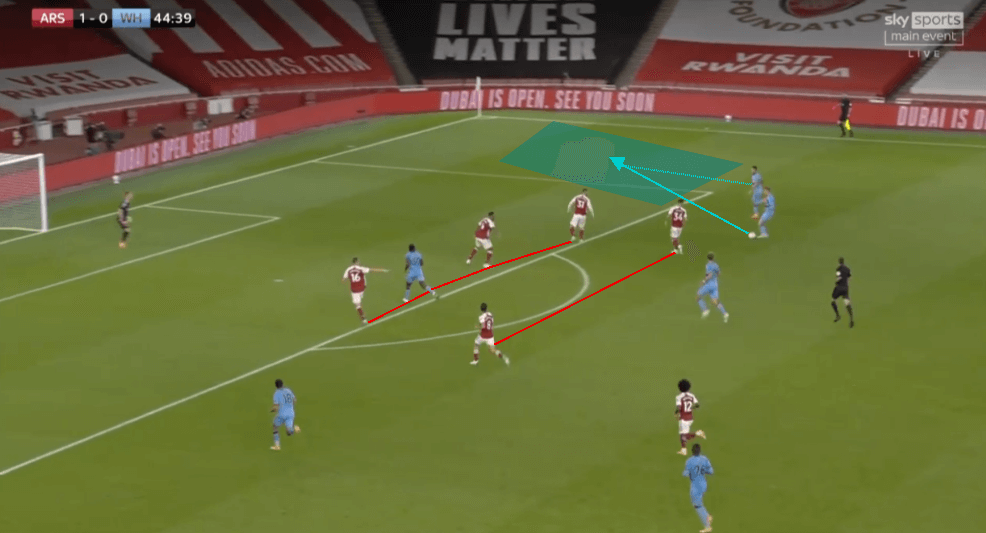
Since Saka is out of position, Arsenal are left powerless to defend the overlapping run of the West Ham wing-back, who has lots of space out wide and can deliver a teasing cross, which is exactly what he does
This is the one major weakness of Arsenal’s new system, and other teams may well look to exploit it. In truth, this got magnified in this instance because Bukayo Saka, a natural winger, was playing as the wing-back. If Mikel Arteta wants a more defensively solid option, he can deploy Ainsley Maitland-Niles, who should be able to deal with counterattacks in a much better way.
Conclusion
Mikel Arteta and his coaching staff deserve a lot of credit for devising this new system, which has worked pretty well so far. The Premier League’s youngest manager has cemented himself among the wisest with these tactics, which even rival those of his former teacher, Pep Guardiola. There is a rare sense of optimism around the Emirates Stadium – one that has been missing since the final months of Arsène Wenger’s reign.
This could well be the start of a great rejuvenation for Arsenal, and Arteta may well be the next big thing as far as managers are concerned. The addition of Thomas Partey gives the Spanish tactician a lot more choices when it comes to his system, so that too should be considered another great positive. But, as always, only time can tell.





Comments